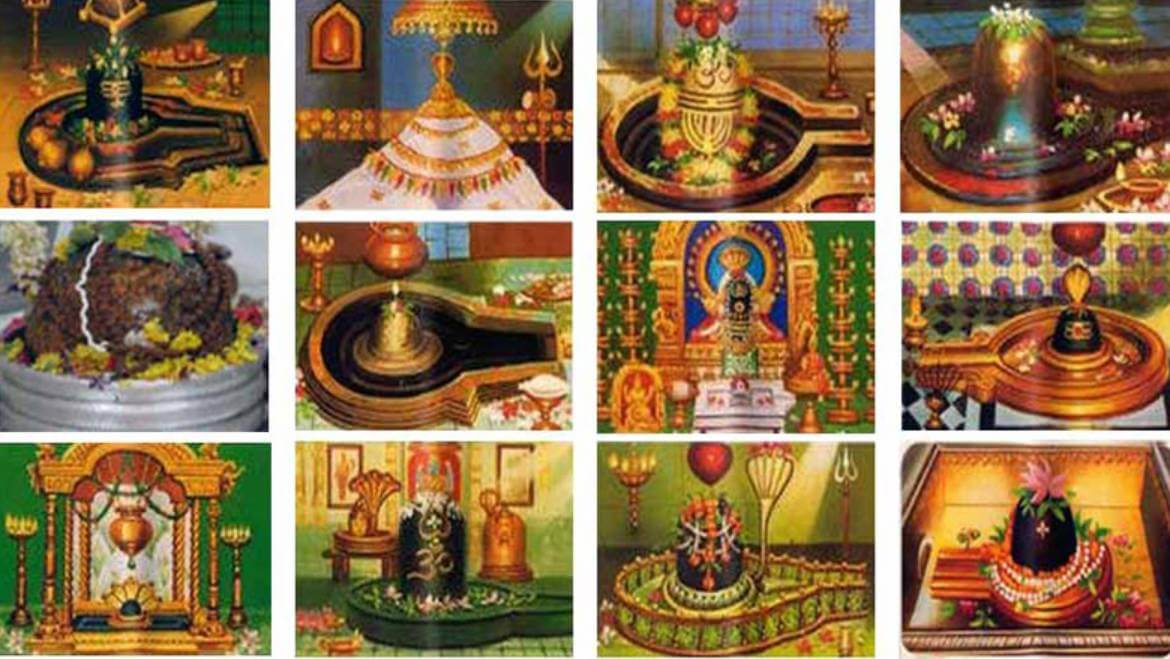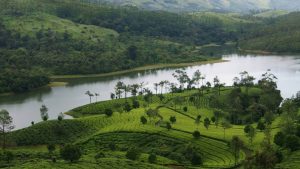Feel the aura of divinity amidst the sacred shrines of Lord Shiva…
From lofty ancient temples to simple village shrines, India’s vast expanses are suffused with divine faith. No matter where your footsteps take you in India, you will always find harmony that flows by the abode of Gods. There is no doubt to say that India is the cradle of gods and demigods and Lord Shiva among them is the most revered god by Hindus all across the world. Lord Shiva, also known as Mahadev- (‘the great God’) is worshipped in the form of Shivling.
The great Lord Shiva is believed to bless all his devotees with salvation. The most unique and divine representation of Lord Shiva are the 12 Jyotirlingas. These 12 Jyotirlingas are also called- Dwadasa Jyotirlingas, which are the most sacred sights of worship in Hinduism. It is also said that the person will be released from the karmic backlog and from the cycle of life and death if he does the darshan of 12 Jyotirlingas.
The Jyotirlingas are the symbol of limitlessness of the form of Shiva, the grandeur of which has been luring devotees since the time unknown. Devotees from all over the world come to see the sacred shrines of Lord Shiva and attain spiritual peace. Listed below are the 12 Jyotirlinga Temples of Lord Shiva along with their mythologies.
List of 12 Jyotirling Temples in India
- Somnath Temple, Gujarat
- Mallikarjuna Temple, Andhra Pradesh
- Mahakaleshwar Temple, Madhya Pradesh
- Omkareshwar Temple and Mamleshwar Temple, Madhya Pradesh
- Baidyanath Dham, Jharkhand
- Bhimashankar Temple, Maharashtra
- Ramanathaswamy Temple, Rameshwaram
- Nageshwar Temple, Gujarat
- Kashi Vishwanath Temple, Uttar pradesh
- Trimbakeshwar Temple, Maharashtra
- Kedarnath Temple, Uttarakhand
- Grishneshwar Temple, Maharashtra
Recommended Tour Package
Somnath Temple, Gujarat
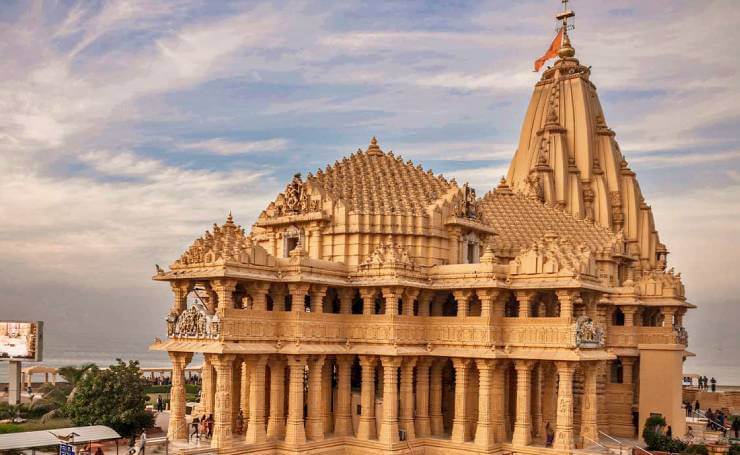
Located in Gir Somnath, Gujarat, on the shores of the Arabian Sea, the ‘Somnath Temple’ is one of the first shrines of the twelve sacred Jyotirlingas. Considered to be the holiest of all Jyotirlinga shrines of India, the temple is visited by thousands of devotees every year, especially on the occasion of Mahashivratri.
Legend
According to a legend, the Moon God, ‘Somdev’ had 27 wives (daughters of Daksha Prajapati), out of them he only loved Rohini and neglected all other wives. Seeing this, Daksha Prajapati cursed the Moon God to have his brightness consumed by the darkness of night. Grief stricken, Moon God prayed to the Jyotirlinga of Lord Shiva for 4000 years at a place where the Somnath Temple is located today.
Pleased with the devotion of Moon, Lord Shiva blessed him to wane in brilliance for only 15 days in a month. After regaining his brightness, the Moon God erected this temple in gratitude to Lord Shiva.
It is said that Lord Brahma told Moon god to build a temple for Lord Shiva. The temple is believed to have been built during the period between 320 and 500 AD.
Originally believed to have been made of pure gold and silver, the temple witnessed massive destruction from Arab and Afghani invaders and by the Mughal emperor, Aurangzeb during different time periods.
Let’s dig a little deeper
These invasions stripped off the temple with all its wealth. Even after all these invasions and destructions, the glory of this pious place remained untouched. In 1947, the temple was restored on the orders of Sardar Vallabhbhai Patel and the Jyotirlinga was installed by the then president Dr. Rajendra Prasad.
Temple Timings – 6:00am to 10:00pm
Other Interesting Blogs to Read
Mallikarjuna Temple, Andhra Pradesh
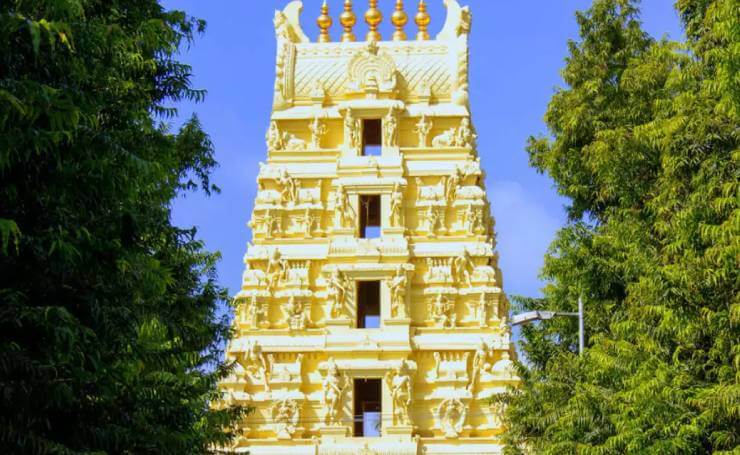
Built around 1234AD, by the Hoyasala King, vira Narsimha, this ancient temple of Mallikarjuna still stands in pride, captivating the hearts of devotees by its divine essence and exquisite Dravidian style of architecture. This is the one of the most splendid sights of worship dedicated to Lord Shiva. The temple is situated on a hill in Srisailam, Andhra Pradesh.
It is said that the shrine of Lord Shiva was installed by Arjuna, one of the Pandavas from the Epic Mahabharata. The Kumbala River close by adds to the relaxing ambiance and beauty of the place.
The temple is decked with all beautiful wall sculptures and carvings which depicts the scenes from Ramayana and Mahabharata. The exquisite sculptures of the temple depicts brilliant sculpting skills of the then Hoysala artisans. Yakshagana Performance every evening is one of the most fascinating sights to behold in this temple.
Legend
According to the Shiv Purana, Lord Shiva took the form of Jyotirlinga here on the Krauncha Mountain, when he along with his wife, Goddess Parvati visited their son, Kartikeya to console him of his anger owing to the marriage of his younger brother, Lord Ganesh, before his.
The temple constitutes the deities of Mallikarjuna (God Shiva) and Bhramarambha (Goddess Parvati). This is the only temple where pilgrims can touch the idols, which is not allowed in any other Shiva temple.
Temple timings- 4:30am to 10:00pm
Note – Jathra Mahotsavam held during the month of March is the most popular attraction of Mallikarjuna Temple.
Other Interesting Blog to Read
Mahakaleshwar Temple Madhya Pradesh
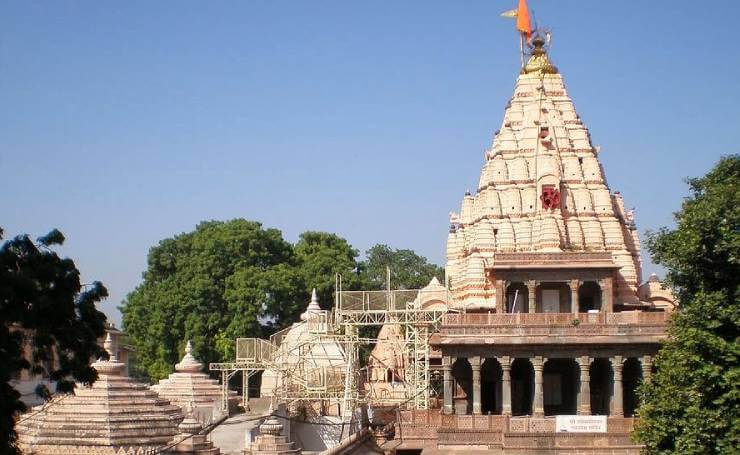
Situated in the historical city of Ujjain, Madhya Pradesh on the banks of River Kshipra, the Mahakaleshwar Temple, apart from being the home to one of the twelve holy Jyotirlingas, is also one of the top ‘Tantra Temples’ of India.
Main highlight of this temple is its ‘Bhasm-Aarti’ that is the first ritual performed in the morning during which the Shivlinga is bathed with the ashes taken from a fresh funeral pyre. Thousands of pilgrims from all over the world visit this temple especially during the month of Sawan and on Nag Panchami.
Legend
There are many mythological stories behind the Mahakaleshwar Temple but, the one that is most frequently heard is that Lord Shiva appeared in Ujjain from the ground to vanquish a demon called Dushana whose tortures on the people and Brahmins of the Ujjain city had crossed all the limits.
After killing the demon, Lord Shiva took the form of Jyotirlinga and since then, he has been residing in this holy city, showering his holy blessings.
Temple Timings: 3:00 AM to 11:00 PM
Other Interesting Blogs to Read
Omkareshwar and Mamleshwar Temple, Madhya Pradesh
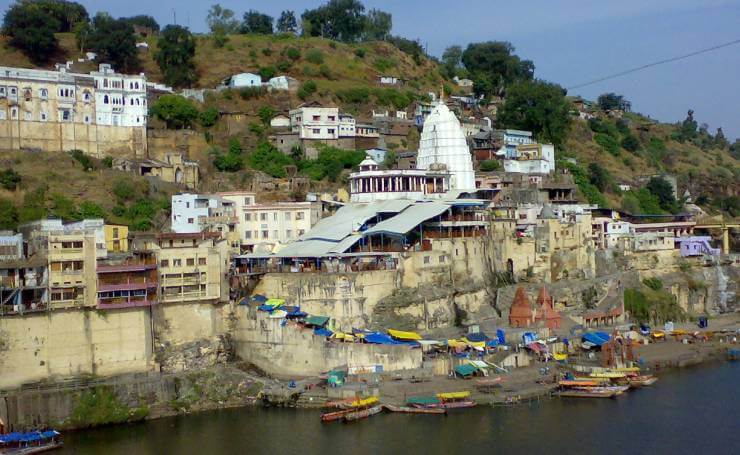
Fourth sacred Jyotirlinga of Lord Shiva resides in the divine ‘Omkareshwar’ and ‘Mamleshwar’ temples at the banks of Narmada River on an island called Mandhata in Madhya Pradesh. It is believed that the island is in the shape of ‘Om’ – a spiritual symbol in Hindu Mythology. Thousands of devotees gather here for the darshans of Omkareshwar Jyotirlinga on the occasions of Shivratri, Mahashivratri and Kartik Poornima. Serene Vibes and picturesque views of the sacred Narmada River adds to the divinity of these shrines. The temple of Mamleshwar is separated from Omkareshwar by a narrow ridge.
Let’s travel back in time
As per the Hindu mythology, there are 3 legends behind the Omkareshwar Jyotirlinga. According to the first legend, ‘Vindhya Parbat’ performed a penance to please Lord Shiva; as a reward Lord Shiva appeared here and blessed the Vindhya Parbat with his wish of being greater than ‘Meru Parbat’. The Linga which was worshipped by Vindhya Parbat was split into two parts ‘Omkareshwar’ and ‘Mamleshwar’ on request of gods and sages. Since then, it is believed Omkareshwar and Mamleshwar temple are the single forms of the same Shiva Lingam.
According to a second story, King Mandhata along with his two sons performed penance. Seeing their devotion, Lord Shiva appeared as a Jyotirlinga. As per the third story, Lord Shiva, in the form of Omkareshwar, defeated the Asuras during a violent war between Devas and Asuras.
Temple Timings: 5:00 AM to 10:00 PM
Other Interesting Blogs to Read
Baidyanath Dham, Jharkhand
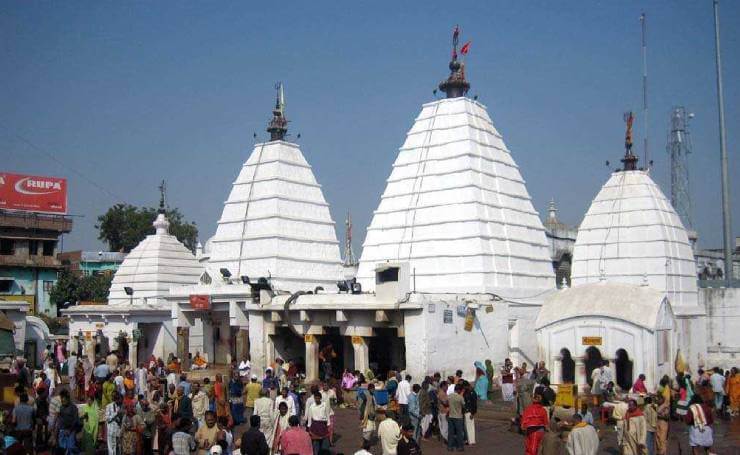
Amongst the 12 Shiva Jyotirlingas, Baidyanath Dham in Jharkhand has several legends attached to it. This temple complex is located in Deoghar in the Santhal Parganas division, adorned with the presence of 21 temples. The sacred Shivalinga existing here is decorated with precious gems. Not only it is one of the 12 Jyotirlingas but also a prominent Shakti peeth, where body parts of Goddess Shakti fell.
During Mughal Rule, Raja Man Singh, the ruler of Amber is said to have built a pond here which is known as Mansarovar. The temple’s pyramidal tower is 72ft high. The eight petaled lotus known as Chandrakanta Mani is the most beautiful sight to behold.
Lord Shiva as Vaidya-(Doctor)
One popular legend here states that this place is where Ravana sacrificed his ten heads in order to gain favor of Lord Shiva. The heads were then joined back by Lord Shiva, who acted like a Vaidya (Doctor), and thus, the place was named as Baidynath Dham. There is a popular belief claiming that offering prayers in this temple renders devotees a healthy and prosperous life. An annual fair during the monsoon months (July and August), brings a lot of devotees to this temple.
Parli Vaidyanath, Sacred and divine too!
There is a slight dispute amongst the believers, as some of them consider the ‘Parli Vaidyanath Temple’ in Maharashtra as one of the 12 Jyotirlingas.
Thus, a large number of devotees also visit this sacred temple in the small village of Parali in Maharashtra. This particular temple is believed to have been rebuilt by Rani Ahilya Bai in 1776 on the slopes of the mountain range – Meru or Naga Narayana.
The village of Parli is very ancient and is also known by other names – Kantipur, Madhyarekha Vaijayanti or Jayanti. Parali is not only a pilgrimage place for devotees of Lord Shiva but also for devotees of Lord Vishnu due to the presence of Harihar Teerth from where water is brought every day to worship Lord Shiva in the Baidyanath Temple.
Big celebrations take place in Parali during the festivals of Mahashivratri, Vaikunth Chaturdashi and Vijayadashami. Pilgrims from across the country gather here in large numbers to take part in these celebrations.
The legend has it, when the gods and demons were churning the ocean for the Divine Nectar/Amrit, fourteen gems emerged including Amrit and Dhanavantari. And just as the demons were about to grab the Amrit, Lord Vishnu managed to pick both Dhanwantri and Amrit and hid them inside a Shivalinga.
When the demons tried to break the Linga, a bright light emanated from it which scared the demons who then fled. Since then, this place came to be known as Parli Vaidyanath.
Highlights – Fascinating Shravan Mela and Buddhist monasteries
Temple Timings- 4:00am to 9:00pm
Other Interesting Blog to Read
Bhimashankar Temple, Maharashtra
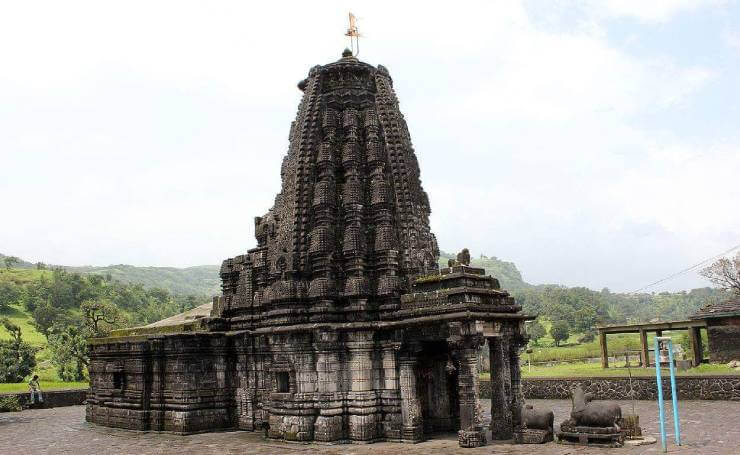
The sixth Jyotirlinga, Bhimashankar Temple is a sight of unequalled grandeur. It is situated in a small village called Bhorgiri amidst the Sahyadri Hills near Pune in Maharashtra.
The place holds a great religious significance owing to the presence of the ‘Bhimashankar Temple’, which is home to another sacred Jyotirlinga of Lord Shiva.
The temple’s Garba Griha is a beautiful amalgamation of Rajasthani and Gujarati influences in its Nagara (Indo Aryan architecture) style. The outer walls of the temple depicts the scenes from Shiv leela, Krishna Leela, Ramayana and Mahabharata.
This mesmerizing piece of worship was built by Nana Phadnavis in the 18th century. Thousands of devotees flock here during the festivals of Shivratri and Maha Shivratri.
Tale from Mythology
According to the Hindu Puranas, Lord Shiva took a rudra avatar to kill a wicked demon called Tripurasura, who was in rage of destroying the three loks: Heaven, Hell and Nether world (Patal). After killing the demon, the Lord sat down on the Sahyadri Mountains to take some rest. It is then, when the sweat from his body started flowing and turned into the Bhima River. On request from Devas, Lord Shiva stayed on these mountains in the form of Jyotirlinga.
Highlights
‘Gupt Bhimashankar’, ‘Hanuman Lake’ and ‘Mokshakund Teertha’ and ‘Kamalja Mata Temple’ are some of the other religious places around Bhimashankar.
Temple Timings: 5:00 AM to 9:00 PM
Recommended Tour Package
Ramanathaswamy Temple, Tamil Nadu
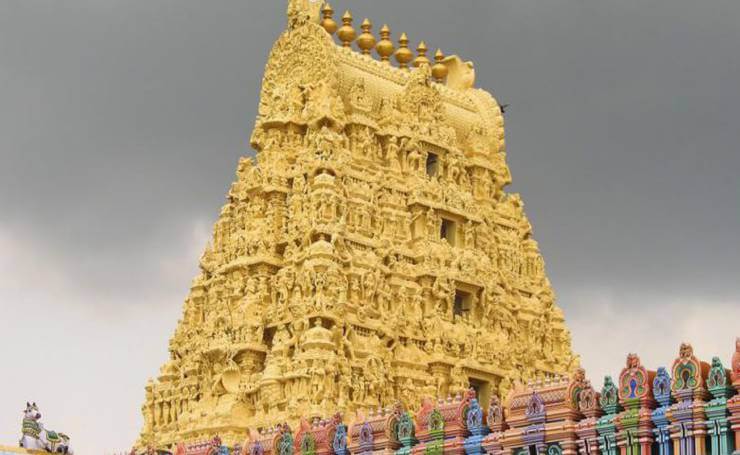
The holy town of Rameshwaram, situated in Tamil Nadu holds a great religious significance for Hindus and is considered to be one of the ‘Char Dham’ pilgrimage sites.
The ‘Ramanathaswamy Temple’ here is home to one of the twelve sacred Jyotirlingas. The temple is a marvelous piece of fine architecture. Majestic towers, sculpted pillars, lavish corridors will absolutely blow your heart away.
Ramanathaswamy Temple is the pillar of Lord Rama’s never-ending faith for Lord Shiva. Testimony to the fact is the name Ramanathaswamy which means Master of Rama.
It is said that Rameshwaram was sanctified by Lord Rama by worshipping Lord Shiva after returning from Lanka, who killed the demon Ravana for abducting his wife Goddess Sita.
To atone for his sins, he wanted to pray to Lord Shiva in the form of Shivling. So, he sent Lord Hanuman to get the biggest lingam from the Himalayas. As Lord Hanuman took very long to get the Shivling, Goddess Sita created a Shivalinga from sand.
Highlights
- Before entering the inner sanctum residing the Shivling, it is mandatory for all devotees to take bath in the 22 ‘theerthams’ or the holy water tanks in the temple complex.
- Around the temple, there are many more sacred sites that include the ‘Agniteertham’, ‘Gandhamadhana Parvatham Temple’, ‘Panchmukhi Hanuman Temple’, ‘Rama Setu’, ‘Jada Tirtham Temple’ and ‘Kothandaramaswamy Temple’.
Temple Timings: 4:30 AM to 8:30 PM
Other Interesting Blogs to Read
Nageshwar Temple, Gujarat
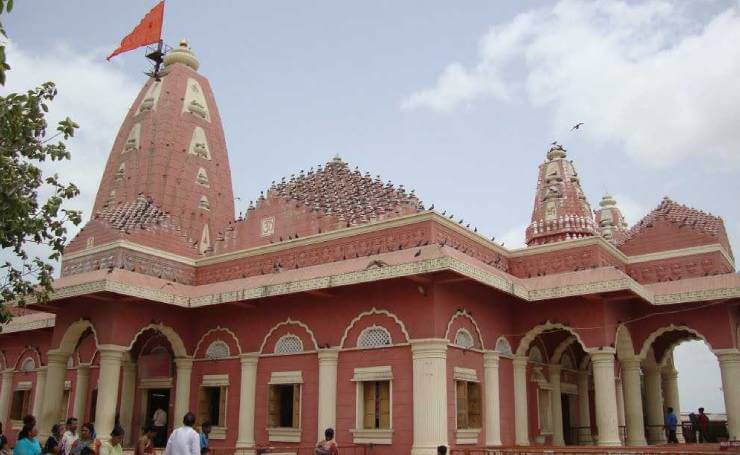
Located near Dwarka, one of the ‘Char Dham’ pilgrimage sites for Hindus, in Gujarat, is the ‘Nageshwar Mahadev Temple’ which is considered to be the home of one of the twelve Jyotirlngas.
The creation date of the temple remains unknown, but at present the temple was renovated by Late Gulshan Kumar in 1996. Thousands of pilgrims visit the temple every year to seek blessings from the Lord Shiva who is worshipped here in the form of ‘Nagdev’. A 25-meter-tall statue of Lord Shiva in a seated position is a great attraction of this temple and provides a perfect backdrop for a nice remembrance picture.
What’s the Legend?
As per the Shiv Purana, a demon named Daruka was blessed by Goddess Parvati, who was a wife of Lord Shiva. Misusing her blessings, Daruka tyrannized the local people and imprisoned a Shiva devotee named Supriya along with some other people.
On advice of Supriya, everyone started chanting the Shiv Mantra to save themselves from Daruka. Seeing this, Daruka raged in anger and ran to kill Supriya, when suddenly Lord Shiva in the form of Jyotirlinga appeared to protect her and other devotees. Since then, the Jyotirlinga is revered here in the Nageshwar Temple.
Temple Timings: 5:00 AM to 9:00 PM
Other Interesting Blogs to Read
Kashi Vishwanath Temple, Uttar Pradesh
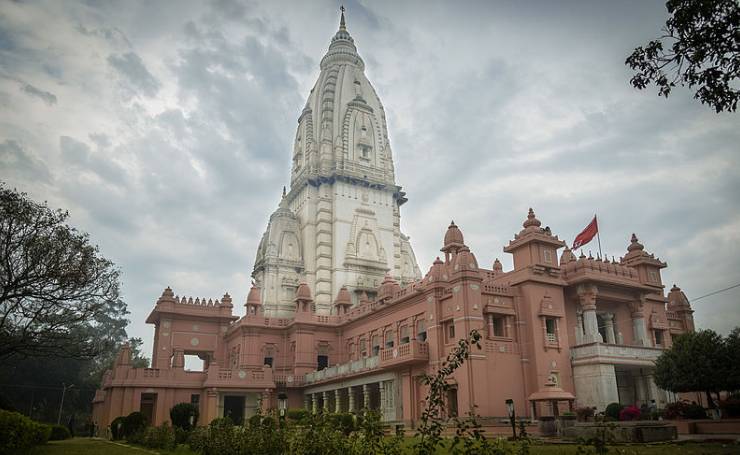
With almost 2000 temples in the city of Banaras/Varanasi, the most sacred is believed to be the ‘Kashi Vishwanath Temple’, which is home to the 12th Jyotirlinga of Lord Shiva. The temple originally dates back to the 11th century and was plundered many times by Afghan and Arab invaders.
The present temple was renovated by Rani Ahilya Bai Holkar in the year 1780. The towers of the temple are gold plated with a golden chhatri on the top. Numerous pilgrims from all over the world gather at Kashi during the festivals of ‘Makar Sankranti’, ‘Kartik Poornima’, ‘Shivratri’, ‘Maha Shivratri’, ‘Dev Diwali’ and ‘Annakoot’.
Let’s revive the Legend
According to the mythological legends, Lord Shiva appeared in the form of an endless pillar of fire to stop Lord Vishnu and Lord Brahma from their ongoing battle for supremacy. Seeing the pillar, Vishnu and Brahma set off in different directions to find the end of the pillar.
While both could not find the ends, Lord Brahma lied to have found the end of the pillar. Seeing this, Lord Shiva got angry and cursed Brahma that he will not be worshipped by anyone and gave Lord Vishnu the title of being supreme. Pillars of fire vanished but a small part of it still remained at Kashi in the form of the Vishwanath Jyotirlinga.
Highlights
Along with the Kashi Vishwanath Temple, other sacred sites including the ‘Annapurna Mata Temple’, ‘Visalakshi Temple’ and ‘Kalbhairav Temple’ are visited by many pilgrims.
Temple Timings: 3:00 AM to 11:00 PM
Also Read
Trimbakeshwar Temple, Maharashtra
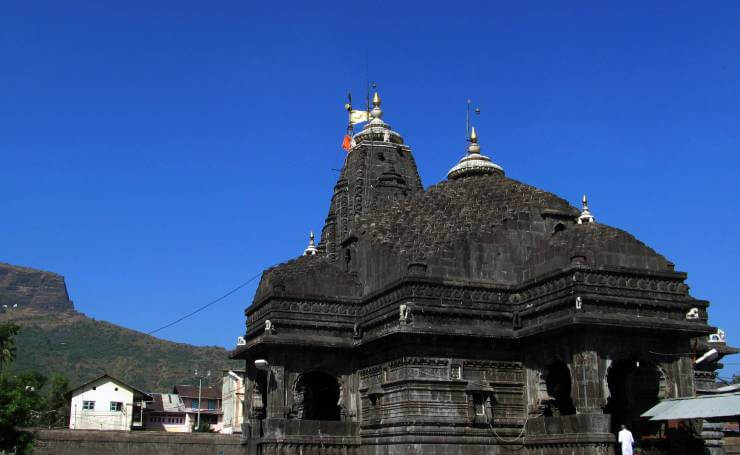
Legacy of the third Peshwa, Balaji Bajirao, the magnificent Trimbakeshwar Temple lures devotees from all over the world to embrace the spiritual whirlwind within themselves. It is situated in a small town of Trimbak near Nashik in Maharashtra.
Picturesque views of Brahmagiri Hill and Kalagiri hill adds to the divine radiance of this temple. The temple is built of black stone in Nagara style of architecture and the inner sanctum houses the Trimbakeshwar Shivling.
One who gets the darshans of the Jyotirlinga gets all his desires fulfilled. There is a pond named Kushavarta in the premises of the temple which is said to be the origin point of Godavari River.
The most fascinating sight is the three faced Shiva Linga which embodies Lord Shiva, Lord Vishnu and Lord Brahma. The Linga is decked with numerous precious stones like Diamond and emeralds etc.
Apart from the main shrine of Trimbakeshwar, Lord Krishna, Goddess Gangadevi, Lord Jaleswara, Lakshmi Narayan, Lord Kedarnath, Lord Rama, Lord Parsurama, Lord Rameshwaram and Lord Gautameshwar adorn the temple.
Legend
As per the legends, sage Gautam once unintentionally caused a cow to die in his hermitage. To purify his sins, he worshipped Lord Shiva and asked him to send River Ganga to purify him. River Ganga flowed down with the name of River Godavari. Seeing this, all gods sang in praise of Lord Shiva and requested him to reside here in the form of Trimbakeshwar Jyotirlinga.
Other legend says that Lord Shiva resides here in the form of three lingas of Brahma, Vishnu and Mahesh and hence the name ‘Trimbakeshwar’. Along with the darshans of Jyotirlinga, pilgrims take a holy dip at ‘Kushavarta’, the sacred place from where River Godavari originates.
Temple Timings: 5:30 AM to 9:00 PM
Also Read: Pilgrimage & Religious Tourism in Maharashtra
Kedarnath Temple, Uttarakhand
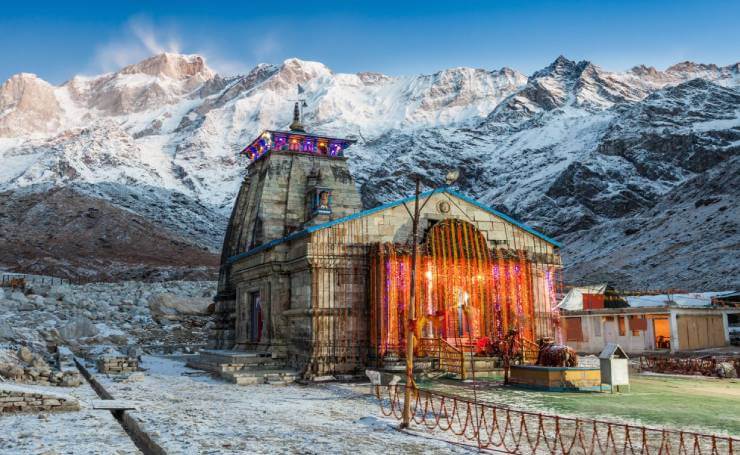
Situated in the Himalayan Range in Uttarakhand, the ‘Kedarnath Temple’ is the highest amongst the twelve Jyotirlingas. The origin of the temple is believed to have been during the time of Mahabharata.
The Kedarnath Temple is also one of the ‘Chota Char Dham’ pilgrimage sites for Hindus. Owing to extreme cold weather on the hills during winters, the temple is closed and the idol of Lord Shiva is brought down at ‘Ukhimath’ where the deity is worshipped during the winter months.
The idol is reinstated in the Kedarnath Temple during the month of Vaisakh as per the Hindu calendars, during which the temple is set open for pilgrims.
According to the legends, Pandavas performed a great penance here to Lord Shiva to absolve their sins after the battle of Mahabharata. Pleased with the Pandavas, Lord Shiva appeared in the form of a triangular Jyotirlinga. The temple was originally built by the Pandavas and was afterwards rebuilt by the Hindu Guru, Adi Shankaracharya.
Temple Timings: 4:00 AM to 9:00 PM
Other Interesting Blogs to Read
Grishneshwar Temple, Maharashtra
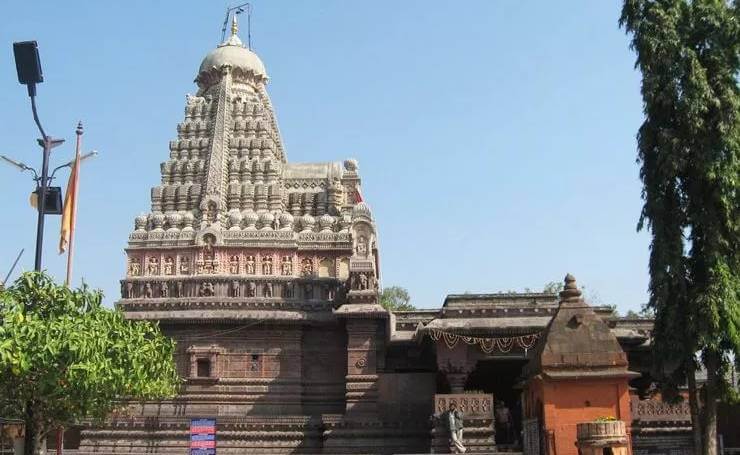
Located at a village called Verul, near Aurangabad in Maharashtra, the ‘Grishneshwar Temple’ dates back to the 18th century. The architecture, paintings and sculptures on temple walls remind the excellent architectural skills of the artisans of the bygone era. Made up of five-tier ‘shikara’ it is the smallest Jyotirlinga temple in India.
According to the Shiv Purana, there was a lady named Ghushma whose son was killed by her own sister. Out of grief she started praying to Lord Shiva, pleased with the devotion of Ghushma, Shiva blessed her with a son. On request of Ghushma, Shiva resided here eternally in the form of Grishneshwar Jyotirlinga.
Temple Timings: 5:00 AM to 9:00 PM
Other Interesting Blogs to Read
It is believed that by taking a holy pilgrimage tour of all these 12 Jyotirlingas, darkness is removed from a person’s life and brings him peace, health and happiness. Please write to us for any missing/incorrect information or to share your experiences and suggestions.
Also Check out
Like & Follow our social media accounts at Twitter, Facebook, Linkedin & Instagram for getting the latest updates & offers on holiday packages.
Disclaimer: We do not take credit for some of the licenced paid images used in our blogs, whether from Google Images, Fotolia & Shutterstock. All such images are the copyrights of their respective owners and we try to provide credit for them wherever we can. If, however, any copyright image has been used on our blog, the concerned person can either mail us directly to remove the image or provide credit to whomsoever the image may belong to.
Frequently Asked Questions
Q.How many days are required to complete the 12 Jyotirlinga temples tour & how can I book this tour?
Minimum 24 -25 days are required to complete the 12 Jyotilinga temples tour in India. TMI organizes 12 Jyotirlinga temples tour at a very affordable price. You can check the complete itinerary on TourmyIndia's website and fill an enquiry form with the details required. Our executive will get back to you within 6-12 hours for further information and booking procedure.
Q.What are some useful tips to travel to the temple holy places of India?
Some of the useful insights to travel to the holy places of India are –
- When you travel to any holy place in India, always wear a covered dress, displaying too much skin is not considered good in the holy places of India.
- Always keep change or small currency notes with you for puja offerings.
- Always clean yourself by washing your feet and hands in the water pools of the temples because cleanliness is godliness.
- Be very careful of pickpockets and always keep a check on your belongings.
- At some religious places, photography is not allowed.
- Respect the decorum of the temples. Always fold your hands if you are in the inner sanctum and keep your shoes outside while entering the temple premises.
Q. Is it mandatory to take bath in Ramanathaswamy temple springs?
It is not compulsory but it is auspicious to take bath in the holy springs of the temple. It is believed that the person who takes bath in Ramanathaswamy temple springs would be free from karmic backlog and sins.
Q.What are some popular tourist attractions to visit near Grishneshwar Temple?
Some popular tourist attractions to visit near Grishneshwar Jyotirling Temple are -
- Ajanta and Ellora Caves
- Bhuteshwar Temple
- Bhimashankar Temple
- Daulatabad Fort
- Chand Minar
- Soneri Mahal
- Mughal Silk Bazaar
Q.Can I perform puja at Kedarnath Temple?
Yes, you can perform Puja at Kedarnath Temple. There are different types of Pujas performed at Kedarnath Temple. You have to book a puja slot from Badri Kedar Temple Samiti for performing any puja.
About the author
She is a candle who burns and melts in the chaos of infinity, from where her visceral whistles and leaves an imprint of desire in her heart to know the map of an Island where there are different sunrises and sunsets. Her curiosity brightens to conquer the hearts unrelieved and sometimes mysterious. Her name is - Pallavi Roy - A traveller by soul and a writer by Profession.

 +91-9212777225
+91-9212777225 Plan Your trip
Plan Your trip